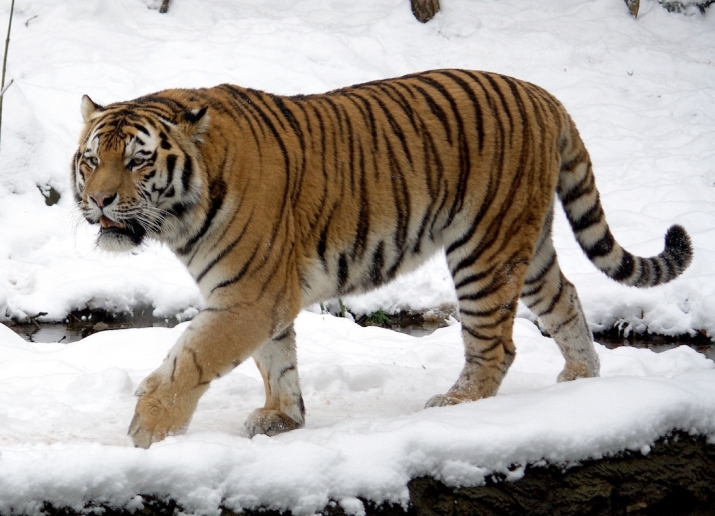NEWS
New Wildlife Reserve Could Help Save China’s Big Cats
 The planned national park in northeastern China could help save the Siberian tiger from extinction. From wikimedia.org
The planned national park in northeastern China could help save the Siberian tiger from extinction. From wikimedia.orgChina’s scarcest and most endangered big cats may stand a renewed chance of escaping extinction, thanks to the tenacious persistence of wildlife biologist Feng Limin and his colleagues from Beijing Normal University. The team’s research has helped to persuade the central government of the need for a new 15,000-square-kilometer national park in northeastern China to protect the dwindling populations of Siberian tigers and Amur leopards, threatened by poaching, logging, and rapid development.
Siberian tigers—the world’s largest cat, weighing in at up to 300 kilograms—mainly live in eastern Russia, northeast China, and in the north of the Korean Peninsula. Only about 500 Siberian tigers are believed to survive in the wild. The Amur leopard, meanwhile, is one of the most endangered of the world’s nine leopard subspecies, but Feng’s research indicates that both populations are showing signs of recovery.
The new reserve, which has yet to be named or formally announced, will be 60 per cent larger than Yellowstone National Park in the US state of Wyoming (established in 1872 and believed to be the first such reserve in the world). Feng and his team have been studying confirmed habitats in the forests of Jilin Province, on China’s border with Russia and North Korea, for the past 10 years, using a network of motion-sensitive cameras to catch glimpses of the elusive Siberian tigers and Amur leopards as they breed and hunt.
While Feng has never encountered one of the big cats in person, the joint research project conducted with the provincial forestry bureau has captured footage indicating that Jilin has a total of 27 Siberian tigers and 46 Amur leopards, suggesting that the cat populations are migrating into northeastern China from Russia. “China now has enough money,” said Feng “We can pay attention to environmental conservation.” (Science)
Under pressure from hunting and habitat loss, scientists believe that populations of both cats were approaching a genetic bottleneck 20 years ago. Ten years ago, it was unclear whether a single big cat remained exclusively on Chinese soil. Siberia has previously offered a lifeline for the big cats, with surveys indicating that Russia's wild tiger population has risen from just 40 in the 1940s to 540 today. According to Feng, that number is stable, but limited by the available habitat in Russia.
David Smith, a tiger expert at the University of Minnesota, Twin Cities, who has visited the proposed park area, agrees: “If they’re going to save this population, it’s really going to be the Chinese, not the Russians,” he said. “All the potential land for expansion is on the China side.” (Science)
 Wildlife biologist Feng Limin, front, has helped to build the case for the new national park. Photo by Yuyang Liu. From sciencemag.org
Wildlife biologist Feng Limin, front, has helped to build the case for the new national park. Photo by Yuyang Liu. From sciencemag.orgForestry officials say establishing the park should also help to ease tensions between the cats and local residents. The deputy director of Jilin Provincial Forestry Bureau's conservation department, Xiao Wanjun, said the government would relocate residents and factories away from the protected areas once the boundaries of the park are established to reduce human contact with the endangered cats, which are occasionally spotted by local residents when they approach villages to prey on dogs, or livestock.
In July, a juvenile tiger reportedly attacked the dog of a local farmer at night, leaving only bones. Sixty-two-year-old farmer Zhou Yamei said this was the first time he had experienced tigers in the area, and now he was afraid to enter the forest to pick mushrooms and wild vegetables.
While Feng acknowledges that effective protection of the tigers and leopards will help to maintain a sound ecosystem in China’s northeast, relocation of human populations will also mean big changes for many farmers who have lived there for generations. Helping locals who lose their livelihoods or homes because of the park will be a critical aspect of the reserve’s success. Park planners hope to turn 30,000 former forest workers—loggers, hunters, and even poachers—into park rangers and conservation workers.
See more
Can a new park save China's big cats? (Science)
Siberian tiger returns to inland China (CCTV.com)
National park to help ease tension between villagers, big cats (Jilin, China)
At least 69 endangered tigers, leopards found in NE China (Jilin, China)
Small group claws its way up (China Daily)
Related
Thailand’s “Tiger Temple” Refuses to Surrender Tigers (Buddhistdoor Global)















